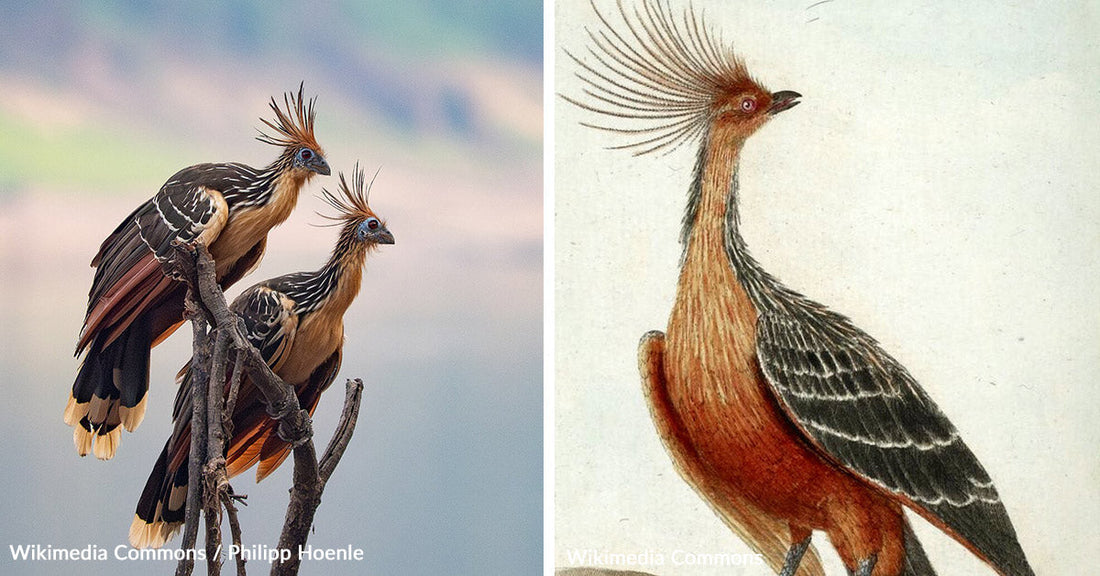7th Annual Holiday Toy & Book Event Help make the holidays brighter this year!
Clawed Chicks and Cow Guts Make This 'Stinky' Amazon Bird a Living Mystery
Matthew Russell
In the tangled mangroves and backwaters of the Amazon and Orinoco basins, there lives a bird so strange it seems to have leapt out of prehistory. Known as the hoatzin, or less flatteringly, the “stinkbird,” this leaf-eating, red-eyed oddball has confounded scientists for decades with its strange blend of primitive traits and head-scratching behaviors.
Part dinosaur, part cow, and all mystery, the hoatzin (Opisthocomus hoazin) might be the weirdest bird in the world.

Photo: Wikimedia Commons / Philipp Hoenle, License: CC0 1.0
The hoatzin is known as the "stinkbird" due to its manure-like odor.
Why It Smells Like a Cow
Most birds don’t smell. The hoatzin does — and not in a good way. This smell is the result of its digestive system, which works more like a cow’s than a typical bird’s. The hoatzin digests its leafy diet through foregut fermentation, using bacteria in a swollen crop to break down tough plant matter. This chamber acts like a bovine rumen, releasing gases that give the bird a pungent odor often compared to manure or rotting vegetation, as Live Science explains.
Though unpleasant, this smell serves a purpose. Many predators avoid the hoatzin, possibly mistaking the stink for rot or poison. According to Animals Around the Globe, the stench is so effective that humans don’t hunt them either — they taste as bad as they smell.
Flightless and Clumsy by Design
The hoatzin’s massive crop isn’t just a smell factory. It also severely limits the bird’s ability to fly. The digestive system takes up so much chest space that the muscles needed for strong flight are underdeveloped. The result? A bird that clambers awkwardly through branches and rarely takes to the sky unless absolutely necessary, Wild Latitudes reports.
Its behavior reflects this design. Hoatzins often perch in small social groups along riverbanks and swamps, chuffing and grunting at intruders rather than fleeing. Despite being clumsy, they are excellent swimmers, a trait that comes in handy for their young.

Photo: Wikimedia Commons / Philipp Hoenle, License: CC0 1.0
The hoatzin is the only bird with a foregut fermentation system.
The Clawed Chicks That Climb
Perhaps the most prehistoric feature of the hoatzin is seen not in the adults, but in the chicks. When hatched, hoatzin chicks have two claws on each wing — a feature not seen in most modern birds. These claws let them climb branches with surprising dexterity, a key survival trait in predator-rich environments. If danger looms, the chicks dive from their nest into water below, swim to safety, and claw their way back up once the coast is clear, Aqua Expeditions notes.
Scientists once thought this trait linked the hoatzin to the *Archaeopteryx*, an ancient flying dinosaur. But while some birds like chickens and ostriches have wing claws, the hoatzin stands out because its claws serve a modern, functional role. According to Indian Defence Review, the climbing behavior of chicks offers strong evolutionary advantages, though it may not prove direct ancestry from dinosaur-era birds.
An Evolutionary Puzzle
No one knows exactly where the hoatzin fits in the bird family tree. Genetic studies in 2015 placed it as a “living fossil,” a relic of a lineage that branched off 64 million years ago, shortly after non-avian dinosaurs vanished from the Earth. But newer research paints a murkier picture. A 2024 study in *PNAS* mapped over 360 bird genomes and could not clearly place the hoatzin, instead assigning it to a group of evolutionary “orphans,” Live Science reports.
This group includes species like cranes and shorebirds but lacks definitive connections. Some experts now believe the hoatzin’s oddities might be the result of unique evolutionary pressures in the Amazon, rather than leftovers from deep time. The question remains: is the hoatzin ancient or just adaptive?

Photo: Wikimedia Commons, License: Public Domain
The digestion process limits its ability to fly, leaving it clumsy in the air.
A Living Reminder of Wild Complexity
Despite its strange anatomy, foul odor, and uncertain past, the hoatzin thrives in the riverine forests of South America. As Animals Around the Globe reports, it is not currently endangered, though deforestation and habitat loss remain long-term threats. This bird, with its cow-like gut, dinosaur claws, and awkward flight, is a living riddle — one still waiting for science to fully solve.
For travelers drifting through the Amazon’s oxbow lakes or scientists mapping avian DNA, the hoatzin is more than a curiosity. It is a living challenge to everything we assume about evolution, biology, and survival.

